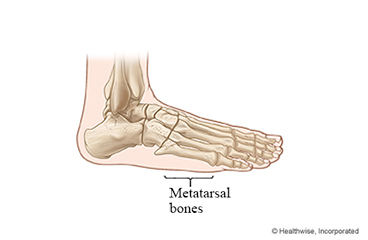Jones Fracture: Care Instructions

Overview
A Jones fracture is a break or a thin (hairline) crack in the fifth metatarsal bone. This is the long bone on the outside of the foot. The break occurs near the end of this bone that's closest to the ankle.
This type of fracture can happen when a person jumps or changes direction quickly and twists the foot or ankle the wrong way. Or it can happen from repeated stress on the bones of the foot.
Treatment depends on how bad the fracture is. You may or may not have had surgery. Your doctor may have put your foot in a cast to keep it stable. A splint may be used in some cases if there is a lot of swelling. You may have been given crutches to use to keep weight off your foot. Your doctor may recommend that you keep weight off the foot for several weeks.
The fracture may take 6 weeks to several months to heal. It is important to give your foot time to heal completely so that you don't hurt it again. Do not return to your usual activities until your doctor says you can. Your doctor may suggest that you get physiotherapy to help regain strength and range of motion in your foot.
Follow-up care is a key part of your treatment and safety. Be sure to make and go to all appointments, and call your doctor or nurse advice line (811 in most provinces and territories) if you are having problems. It's also a good idea to know your test results and keep a list of the medicines you take.
How can you care for yourself at home?
- Be safe with medicines. Read and follow all instructions on the label.
- If the doctor gave you a prescription medicine for pain, take it as prescribed.
- If you are not taking a prescription pain medicine, ask your doctor if you can take an over-the-counter medicine.
- Follow your doctor's instructions about how much weight you can put on your foot and when you can go back to your usual activities. If you were given crutches, use them as directed.
- Put ice or a cold pack on your foot for 10 to 20 minutes at a time. Try to do this every 1 to 2 hours for the next 3 days (when you are awake) or until the swelling goes down. Put a thin cloth between the ice and your skin.
- Prop up your foot on a pillow when you ice it or anytime you sit or lie down for the next 3 days. Try to keep it above the level of your heart. This will help reduce swelling.
- Take care of your cast or splint.
- If your foot is in a cast or splint, follow the cast or splint care instructions your doctor gives you. If you have a removable fibreglass walking cast or a splint, do not take it off unless your doctor tells you to.
- Keep your cast or splint dry. If you have a removable fibreglass walking cast or a splint, ask your doctor if it is okay to remove it to bathe. Your doctor may want you to keep it on as much as possible.
- If you are told to keep your cast or splint on, tape a sheet of plastic to cover it when you bathe. Water under the cast or splint can cause your skin to itch and hurt.
- Never cut your cast or stick anything down inside it to scratch an itch on your leg.
When should you call for help?
Call 911 anytime you think you may need emergency care. For example, call if:
- You have symptoms of a blood clot in your lung (called a pulmonary embolism). These may include:
- Sudden chest pain.
- Trouble breathing.
- Coughing up blood.
- You passed out (lost consciousness).
Call your doctor or nurse advice line now or seek immediate medical care if:
- You have problems with your cast or splint. For example:
- The skin under the cast or splint is burning or stinging.
- The cast or splint feels too tight.
- There is a lot of swelling near the cast or splint. (Some swelling is normal.)
- You have a new fever.
- There is drainage or a bad smell coming from the cast or splint.
- You have increased or severe pain.
- You have tingling, weakness, or numbness in your foot and toes.
- You cannot move your toes.
- Your foot turns cold or changes colour.
Watch closely for changes in your health, and be sure to contact your doctor or nurse advice line if:
- The pain does not get better day by day.
- You do not get better as expected.
Where can you learn more?
Go to https://www.healthwise.net/patientEd
Enter R910 in the search box to learn more about "Jones Fracture: Care Instructions".
Current as of: July 31, 2024
